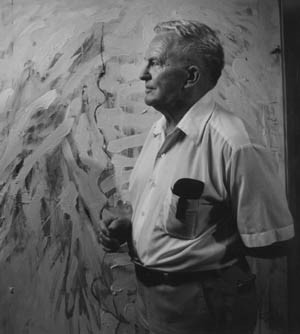Hiram D. Williams
Painter

1917 - 2003
Inducted in 1994
Biography
Hiram D. Williams was a painter best known for his powerful, impressionistic figurative images that evoke the spectrum of human emotions ranging from the tragic to the comic. While serving as a faculty member of the University of Florida's art department, Williams established a national reputation as a major force in 20th Century art.
Born in Indianapolis, Indiana, Williams grew up in the small town of Muncy, Pennsylvania, the son of a Baptist minister. As a youth, his mother noticed his talent for drawing and encouraged him by arranging for drawing and painting lessons. Williams complemented his interest in art with a passion for reading, and he became a fixture in the local public library.
Like millions of young people growing up with few job prospects in the Great Depression, after high school Williams lived with his parents and practiced his painting. In 1940, he got a chance to join the Art Student's League in New York, but a lack of tuition money forced him to drop out after only three months.
Williams soon found himself facing the prospects of going to war. In June 1941 he was inducted into the U.S. Army, and the following year was made an officer, rising to the rank of captain and assigned to a combat engineering outfit. Eventually he was shipped to Europe where he joined the Fifth Army, under command of Gen. George S. Patton.
The frightful carnage he witnessed on the battlefields in Italy and France had a jarring effect on Williams, shaking the foundations of his beliefs about life, philosophy and, in particular, his father's conservative theology. His war experience profoundly changed his outlook, and thus his art, for the rest of his life.
Returned from the war, Williams got married and found a low-paying job in Philadelphia drawing cartoons. In Philadelphia he was introduced to modern art, and he saw for the first time how he could best express his anxieties over the human predicament. Qualified for the G.I. Bill, he enrolled at Penn State University where he pursued a career in art education.
After graduation, Williams spent the next 10 years teaching art at various places, including the University of Southern California, but depression and other set-backs (mainly severe family medical expenses) hindered his prospects in both education and in art. Finally, he landed a teaching job at the University of Texas, where his fortunes soon improved. Finding his grounding in a style of impressionism inspired by the human figure, Williams' career and reputation as a major artist bounded.
In 1960, Williams' momentum in the art world carried him to a teaching post within the University of Florida's art department and eventually, fame. New York's art community soon took notice, and some of Williams' best works were purchased by the Museum of Modern Art and The Whitney Museum of Art. Manhattan's Nordness Gallery gave Williams a one-man show, a collection that later toured the U.S, England and Japan (the paintings are now part of the Smithsonian's collection).
During his 22 years at the University of Florida, Williams produced an impressive body of artwork. But he also remained a dedicated and popular teacher. In 1963, Prentice-Hall published his book intended for students, Notes for a Young Painter.
Williams retired from teaching in 1982, and in 1987 donated to the University of Florida's Harn Museum a large collection of his paintings that remains the most comprehensive anywhere.

